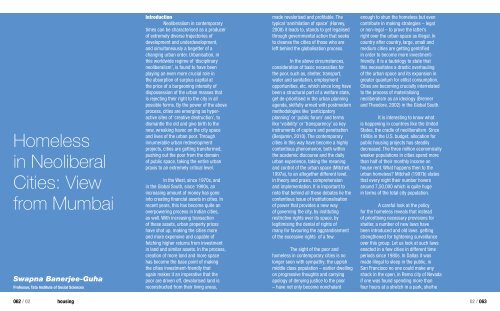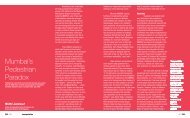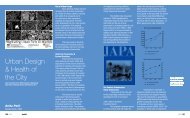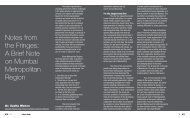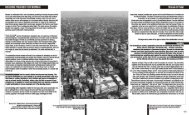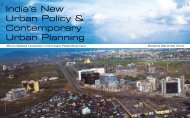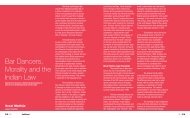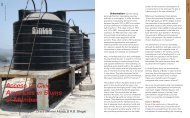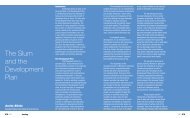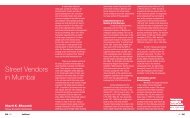Homeless in Neoliberal Cities: View from Mumbai - Urban Design ...
Homeless in Neoliberal Cities: View from Mumbai - Urban Design ...
Homeless in Neoliberal Cities: View from Mumbai - Urban Design ...
Create successful ePaper yourself
Turn your PDF publications into a flip-book with our unique Google optimized e-Paper software.
<strong>Homeless</strong><br />
<strong>in</strong> <strong>Neoliberal</strong><br />
<strong>Cities</strong>: <strong>View</strong><br />
<strong>from</strong> <strong>Mumbai</strong><br />
Swapna Banerjee-Guha<br />
Professor, Tata Institute of Social Sciences<br />
Introduction<br />
<strong>Neoliberal</strong>ism <strong>in</strong> contemporary<br />
times can be characterised as a producer<br />
of extremely diverse trajectories of<br />
development and underdevelopment,<br />
and simultaneously a begetter of a<br />
chang<strong>in</strong>g urban order. <strong>Urban</strong>isation, <strong>in</strong><br />
this worldwide regime of ‘discipl<strong>in</strong>ary<br />
neoliberalism’, is found to have been<br />
play<strong>in</strong>g an even more crucial role <strong>in</strong><br />
the absorption of surplus capital at<br />
the price of a burgeon<strong>in</strong>g <strong>in</strong>tensity of<br />
dispossession of the urban masses that<br />
is reject<strong>in</strong>g their right to the city <strong>in</strong> all<br />
possible forms. By the power of the above<br />
process, cities are emerg<strong>in</strong>g as hyperactive<br />
sites of ‘creative destruction’, to<br />
dismantle the old and give birth to the<br />
new, wreak<strong>in</strong>g havoc on the city space<br />
and lives of the urban poor. Through<br />
<strong>in</strong>numerable urban redevelopment<br />
projects, cities are gett<strong>in</strong>g transformed,<br />
push<strong>in</strong>g out the poor <strong>from</strong> the doma<strong>in</strong><br />
of public space, tak<strong>in</strong>g the entire urban<br />
praxis to an extremely critical level.<br />
In the West, s<strong>in</strong>ce 1970s, and<br />
<strong>in</strong> the Global South, s<strong>in</strong>ce 1990s, an<br />
<strong>in</strong>creas<strong>in</strong>g amount of money has gone<br />
<strong>in</strong>to creat<strong>in</strong>g f<strong>in</strong>ancial assets <strong>in</strong> cities. In<br />
recent years, this has become quite an<br />
overpower<strong>in</strong>g process <strong>in</strong> Indian cities,<br />
as well. With <strong>in</strong>creas<strong>in</strong>g transaction<br />
of these assets, urban property prices<br />
have shot up, mak<strong>in</strong>g the cities more<br />
and more expensive and capable of<br />
fetch<strong>in</strong>g higher returns <strong>from</strong> <strong>in</strong>vestment<br />
<strong>in</strong> land and similar assets. In the process,<br />
creation of more land and more space<br />
has become the base po<strong>in</strong>t of mak<strong>in</strong>g<br />
the cities <strong>in</strong>vestment-friendly that<br />
aga<strong>in</strong> makes it an imperative that the<br />
poor are driven off, devalorised land is<br />
reconstructed <strong>from</strong> their liv<strong>in</strong>g areas,<br />
made revalorised and profitable. The<br />
typical ‘annihilation of space’ (Harvey,<br />
2008) it leads to, stands to get legalised<br />
through governmental action that seeks<br />
to cleanse the cities of those who are<br />
left beh<strong>in</strong>d the globalisation process.<br />
In the above circumstances,<br />
consideration of basic necessities for<br />
the poor, such as, shelter, transport,<br />
water and sanitation, employment<br />
opportunities, etc. which s<strong>in</strong>ce long have<br />
been a structural part of a welfare state,<br />
get de-prioritised <strong>in</strong> the urban plann<strong>in</strong>g<br />
agenda, skilfully armed with postmodern<br />
methodologies like ‘participatory<br />
plann<strong>in</strong>g’ or ‘public forum’ and terms<br />
like ‘visibility’ or ‘transparency’ as key<br />
<strong>in</strong>struments of capture and penetration<br />
(Benjam<strong>in</strong>, 2010). The contemporary<br />
cities <strong>in</strong> this way have become a highly<br />
contentious phenomenon, both with<strong>in</strong><br />
the academic discourse and the daily<br />
urban experience, tak<strong>in</strong>g the mean<strong>in</strong>g<br />
and control of the urban space (Mitchell,<br />
1997a), to an altogether different level,<br />
<strong>in</strong> theory and praxis, comprehension<br />
and implementation. It is important to<br />
note that beh<strong>in</strong>d all these debates lie the<br />
contentious issue of <strong>in</strong>stitutionalisation<br />
of power that provides a new way<br />
of govern<strong>in</strong>g the city, by <strong>in</strong>stitut<strong>in</strong>g<br />
restrictive rights over its space, by<br />
legitimis<strong>in</strong>g the denial of rights of<br />
many for favour<strong>in</strong>g the aggrandisement<br />
of the excessive rights of a few.<br />
The sight of the poor and<br />
homeless <strong>in</strong> contemporary cities is no<br />
longer seen with sympathy; the uppish<br />
middle class population – earlier dwell<strong>in</strong>g<br />
on progressive thoughts and carry<strong>in</strong>g<br />
apology of deny<strong>in</strong>g justice to the poor<br />
– have not only become nonchalant<br />
enough to shun the homeless but even<br />
contribute <strong>in</strong> mak<strong>in</strong>g strategies – legal<br />
or non-legal – to prove the latter’s<br />
right over the urban space as illegal. In<br />
country after country, large, small and<br />
medium cities are gett<strong>in</strong>g gentrified<br />
<strong>in</strong> order to become more <strong>in</strong>vestmentfriendly.<br />
It is a tautology to state that<br />
this necessitates a drastic overhaul<strong>in</strong>g<br />
of the urban space and its expansion <strong>in</strong><br />
greater quantum for elitist consumption.<br />
<strong>Cities</strong> are becom<strong>in</strong>g crucially <strong>in</strong>terrelated<br />
to the process of materialis<strong>in</strong>g<br />
neoliberalism as an ideology (Brenner<br />
and Theodore, 2002) <strong>in</strong> the Global South.<br />
It is <strong>in</strong>terest<strong>in</strong>g to know what<br />
is happen<strong>in</strong>g <strong>in</strong> countries like the United<br />
States, the cradle of neoliberalism. S<strong>in</strong>ce<br />
1980s <strong>in</strong> the U.S. budget, allocation for<br />
public hous<strong>in</strong>g projects has steadily<br />
decreased. The three million economically<br />
weaker populations <strong>in</strong> cities spend more<br />
than half of their monthly <strong>in</strong>come on<br />
house rent. What happens then to the<br />
urban homeless Mitchell (1997b) states<br />
that every night their number hovers<br />
around 7,50,000 which is quite huge<br />
<strong>in</strong> terms of the total city population.<br />
A careful look at the policy<br />
for the homeless reveals that <strong>in</strong>stead<br />
of prioritis<strong>in</strong>g necessary provisions for<br />
shelter, a number of new laws have<br />
been <strong>in</strong>troduced and old laws gett<strong>in</strong>g<br />
strengthened for tighten<strong>in</strong>g surveillance<br />
over this group. Let us look at such laws<br />
enacted <strong>in</strong> a few cities <strong>in</strong> different time<br />
periods s<strong>in</strong>ce 1980s. In Dallas it was<br />
made illegal to sleep <strong>in</strong> the public, <strong>in</strong><br />
San Francisco no one could make any<br />
shack <strong>in</strong> the open, <strong>in</strong> Remo city of Nevada<br />
if one was found spend<strong>in</strong>g more than<br />
four hours at a stretch <strong>in</strong> a park, she/he<br />
062 / 02 hous<strong>in</strong>g<br />
02 / 063
would face arrest. In Chicago, begg<strong>in</strong>g<br />
was made illegal and <strong>in</strong> New York,<br />
sleep<strong>in</strong>g <strong>in</strong> the tra<strong>in</strong> (Mitchell, 1997b).<br />
Accord<strong>in</strong>g to Harvey (1989),<br />
all these surveillance laws are meant to<br />
destroy the organic relationship between<br />
people (especially the poor) and space.<br />
These punitive laws look at the poor as<br />
a specific socio-economic class and are<br />
used as weapons of class war aga<strong>in</strong>st<br />
them. The need for promot<strong>in</strong>g such laws<br />
is clear <strong>in</strong> the m<strong>in</strong>ds of the lawmakers.<br />
Accord<strong>in</strong>g to them, it is the poor who<br />
br<strong>in</strong>g down the quality of life <strong>in</strong> cities<br />
and should be held responsible for the<br />
reduction of open spaces and greens.<br />
Follow<strong>in</strong>g this view, <strong>in</strong> 1999, <strong>in</strong> Santa Ana<br />
city of California, the police were given<br />
the power to arrest the homeless without<br />
any reason, for the purpose of putt<strong>in</strong>g an<br />
<strong>in</strong>k stamp on their body for their homeless<br />
identity that helped the adm<strong>in</strong>istration<br />
to drive them out <strong>from</strong> the city.<br />
Rid<strong>in</strong>g the wave of such ideas,<br />
the New York mayor Rudolf Giuliani<br />
became popular among the middle and<br />
upper middle class when he enacted<br />
a number of <strong>in</strong>human laws aga<strong>in</strong>st the<br />
homeless, the culm<strong>in</strong>ation of which was<br />
seen <strong>in</strong> a cold December night <strong>in</strong> 1991 <strong>in</strong><br />
Tompk<strong>in</strong>s Square Park when the police<br />
raided the park and brutally drove out<br />
the homeless <strong>from</strong> their shacks (Smith,<br />
1998). In the United K<strong>in</strong>gdom, the number<br />
of homeless <strong>in</strong> the capital city of London<br />
<strong>in</strong>creased by 15 per cent <strong>from</strong> 2003 to<br />
2009. Although the government plans<br />
to stop sleep<strong>in</strong>g <strong>in</strong> streets by 2012,<br />
the local council offices show extreme<br />
reluctance to assist the homeless <strong>in</strong><br />
gett<strong>in</strong>g governmental assistance as<br />
it helps to keep the official number<br />
of the homeless low. The number of<br />
homeless <strong>in</strong> cities like Toronto, Paris or<br />
Munich has magnified <strong>in</strong> recent years.<br />
In Hong Kong, the homeless live<br />
<strong>in</strong> ‘cage homes’, an <strong>in</strong>human arrangement<br />
of iron beds tied up on all four sides<br />
with wire; one bed sits on the other and<br />
goes up to four (Banerjee-Guha, 2010b).<br />
In Tokyo, <strong>in</strong> 2001, the author found the<br />
homeless scattered <strong>in</strong> the famous Ueno<br />
Park of the metropolis, outside railway<br />
stations, on the other side of the Sumida<br />
river, liv<strong>in</strong>g <strong>in</strong> shacks, tents and cardboard<br />
boxes. Official statistics state that the<br />
homeless <strong>in</strong> Tokyo numbers around<br />
4000. Every year 300-400 die on the<br />
streets; dur<strong>in</strong>g w<strong>in</strong>ter, the frequency<br />
of death rises. In the red light district<br />
of Kabuki-Cho, <strong>in</strong>ternet cafes are kept<br />
open for twenty four hours to help<br />
the homeless have a roof <strong>in</strong> the night.<br />
S<strong>in</strong>ce 1990s the homeless problem has<br />
atta<strong>in</strong>ed a critical nature <strong>in</strong> Hong Kong<br />
and Tokyo and several emergency laws<br />
are be<strong>in</strong>g enacted to sanitise the cities.<br />
<strong>Homeless</strong> are seen <strong>in</strong> different locations<br />
<strong>in</strong>side the ‘urban villages’ <strong>in</strong> the modern<br />
cities of Shenzhen or Guangzhou <strong>in</strong><br />
Ch<strong>in</strong>a (Banerjee-Guha, 2010b) too.<br />
Waldron (1991) states that<br />
the condition of be<strong>in</strong>g homeless <strong>in</strong><br />
entrepreneurial, neoliberal cities <strong>in</strong><br />
current times is simply a matter of not<br />
hav<strong>in</strong>g any place to call one’s own. In<br />
a ‘libertarian paradise’ where private<br />
property and ownership is the end of all<br />
mantras, the homeless simply does not<br />
exist, <strong>in</strong> other words, need not exist.<br />
‘What is emerg<strong>in</strong>g – and it is<br />
not just a matter of fantasy – is a state of<br />
affairs <strong>in</strong> which a million or more citizens<br />
have no place to perform elementary<br />
home activities like ur<strong>in</strong>at<strong>in</strong>g, wash<strong>in</strong>g,<br />
sleep<strong>in</strong>g, cook<strong>in</strong>g, eat<strong>in</strong>g and stand<strong>in</strong>g<br />
around. People who own private places<br />
<strong>in</strong> … which they can do these th<strong>in</strong>gs<br />
are <strong>in</strong>creas<strong>in</strong>gly decid<strong>in</strong>g to make public<br />
spaces available only for activities other<br />
than these primal human tasks … S<strong>in</strong>ce<br />
the public and private are complementary,<br />
the activities performed <strong>in</strong> public are<br />
the complements of those performed <strong>in</strong><br />
private. These complementarities work<br />
f<strong>in</strong>e for those who have the benefit of both<br />
sorts of places. However, it is disastrous<br />
for those who must live their whole<br />
lives on common land … It is the most<br />
callous and tyrannical exercise of power<br />
<strong>in</strong> modern times by a (comparatively)<br />
rich and complacent majority aga<strong>in</strong>st<br />
a m<strong>in</strong>ority of their less fortunate fellow<br />
human be<strong>in</strong>gs’ (Waldron, 1991: 301-302).<br />
Contemporary <strong>Urban</strong> Scenario <strong>in</strong> India<br />
India is no exception to the<br />
above rule. A major overhaul<strong>in</strong>g of the<br />
adm<strong>in</strong>istrative and legislative framework<br />
of the government <strong>in</strong> the early 1990s<br />
and <strong>in</strong>volvement of the IFIs (International<br />
F<strong>in</strong>ancial Institutions) gradually<br />
smoothened the aggressive redraft<strong>in</strong>g of<br />
a pan-Indian urban plann<strong>in</strong>g proposal that<br />
<strong>in</strong> 2005 f<strong>in</strong>ally led to the formulation of<br />
the largest ever urban reforms mandate<br />
s<strong>in</strong>ce <strong>in</strong>dependence. The Jawaharlal<br />
Nehru <strong>Urban</strong> Renewal Mission (JNNURM)<br />
as it is popularly known has the World<br />
Bank, Asian Development Bank (ADB),<br />
United States Agency for International<br />
Development (USAID) or the United<br />
K<strong>in</strong>gdom’s Department of International<br />
Development (DFID) as its mentors<br />
(Banerjee-Guha, 2009). It has <strong>in</strong>itiated a<br />
new regime of regulation <strong>in</strong> the Indian<br />
urban sector that has cleared the ground<br />
for rigorous implementation of neoliberal<br />
programmes (mostly state sponsored,<br />
at central and regional levels) <strong>in</strong> several<br />
cities located <strong>in</strong> different parts of the<br />
country, impact<strong>in</strong>g the urban economic<br />
base, municipal f<strong>in</strong>ance, <strong>in</strong>frastructure,<br />
basic services, land and hous<strong>in</strong>g<br />
market, land use, urban form and most<br />
importantly, the shelter and livelihoods<br />
of millions of urban poor. Reproduction<br />
of urban space under this framework<br />
essentially reflects the contradictions<br />
of economic globalization at local<br />
scale (Sassen, 1999), expos<strong>in</strong>g a deep<br />
structural imbalance <strong>in</strong> which modernity<br />
and post-modernity are marked with<br />
ephemerality and chaotic flux (Harvey,<br />
1990; Banerjee-Guha, 2006). The erosion<br />
of social justice content at policy level<br />
expresses the impact of the above<br />
restructur<strong>in</strong>g on political and cultural<br />
life of cities (Banerjee-Guha, 2006) that<br />
has put the concern for general welfare,<br />
labour security and protection to the<br />
poor at stake. For example, <strong>in</strong> the place<br />
of commitment to social hous<strong>in</strong>g, there<br />
has emerged a legal war on the poor<br />
(Mitchell, 1997b). Earlier, the way to solve<br />
the problem of urban homeless was to<br />
get <strong>in</strong>volved <strong>in</strong> public hous<strong>in</strong>g projects,<br />
provision of basic services, organised<br />
employment opportunities, facilities of<br />
health education, etc.. Follow<strong>in</strong>g the<br />
wave of economic globalisation, cities<br />
like <strong>Mumbai</strong>, Bangalore, Hyderabad<br />
and many others, have become more<br />
<strong>in</strong>terested <strong>in</strong> woo<strong>in</strong>g the real estate<br />
and builders to redevelop slums and<br />
dilapidated open spaces on a commercial<br />
basis to transform the face of the ‘urban’<br />
altogether. Although the fate of the<br />
slum dwellers <strong>in</strong> such ‘free’ hous<strong>in</strong>g<br />
became known to all, the real estate<br />
sector is rewarded for such projects<br />
064 / 02<br />
hous<strong>in</strong>g 03 / 065
through <strong>in</strong>numerable subsidies Among<br />
the slum dwellers, even if some manage<br />
to get hold of a dwell<strong>in</strong>g unit after go<strong>in</strong>g<br />
through <strong>in</strong>numerable formalities, there<br />
is no guarantee that they will be able<br />
to cont<strong>in</strong>ue there. Firstly, because of<br />
the <strong>in</strong>sufficiency of space <strong>in</strong> the new<br />
units for carry<strong>in</strong>g out their economic<br />
enterprises they are forced to look for<br />
some appropriate space elsewhere<br />
and secondly, because of the <strong>in</strong>creased<br />
vulnerability of the entire area due to<br />
market pressure, they are <strong>in</strong> a constant<br />
state of <strong>in</strong>security that leads to a second<br />
spate of displacement. Compared to slum<br />
dwellers, conditions of the homeless is<br />
much more precarious as they do not<br />
have any chance to get access even to<br />
such hous<strong>in</strong>g. It is, therefore, be<strong>in</strong>g argued<br />
that the erstwhile public hous<strong>in</strong>g projects<br />
for the poor should be identified as the<br />
end of the aspect of modernism that saw<br />
the cities also as site for construct<strong>in</strong>g<br />
a more <strong>in</strong>clusive society. The emerg<strong>in</strong>g<br />
lack of concern of the State towards<br />
accommodat<strong>in</strong>g the poor <strong>in</strong> the city as<br />
an <strong>in</strong>tegrative part essentially marks the<br />
end of an ideal <strong>in</strong> which the poor <strong>in</strong> the<br />
city were entitled to m<strong>in</strong>imally decent<br />
hous<strong>in</strong>g and other opportunities through<br />
state <strong>in</strong>tervention, to access education<br />
and experience a steady advancement<br />
<strong>in</strong> their lives (Mitchell, 2001).<br />
<strong>Urban</strong> neoliberalism (Banerjee-<br />
Guha, 2009; 2010a), <strong>in</strong> theory and praxis,<br />
has truly marked the beg<strong>in</strong>n<strong>in</strong>g of an<br />
era of ‘heterotopia’ that happens to be<br />
extremely confus<strong>in</strong>g to guide for any<br />
social praxis that has its goal <strong>in</strong> social<br />
justice. Indian cities now are drastically<br />
reshap<strong>in</strong>g themselves to become the<br />
core centres of <strong>in</strong>vestment of big capital.<br />
The urban local bodies <strong>in</strong> several cities,<br />
as a part of the neoliberal agenda of<br />
the JNNURM, are receiv<strong>in</strong>g loans <strong>from</strong><br />
commercial <strong>in</strong>stitutions, such as, the<br />
World Bank, Asian Development Bank<br />
or DFID for develop<strong>in</strong>g <strong>in</strong>frastructure<br />
that aga<strong>in</strong> is work<strong>in</strong>g aga<strong>in</strong>st the cause<br />
of public welfare (Ramachandraiah,<br />
2009; Pakalapati, 2010; Bhowmik,<br />
2010). The contemporary cities are<br />
develop<strong>in</strong>g a structural tendency towards<br />
<strong>in</strong>creas<strong>in</strong>g social <strong>in</strong>equality, mak<strong>in</strong>g the<br />
disadvantaged sections of the society<br />
more vulnerable. All redevelopment<br />
projects, be it commercial, residential or<br />
even cultural/recreational, are gigantic -<br />
of mega order, reflect<strong>in</strong>g a stance of the<br />
‘global’: the new office complexes, malls,<br />
exhibition centres, stadia, enterta<strong>in</strong>ment<br />
complexes – all have a character of a<br />
‘demonic other’, that does not <strong>in</strong>tegrate<br />
the less affordable sections of the society<br />
as users (Banerjee-Guha, 2010b). All<br />
open spaces, slums, low <strong>in</strong>come hous<strong>in</strong>g<br />
areas, at times, middle class areas<br />
also are gett<strong>in</strong>g appropriated by the<br />
above design of usher<strong>in</strong>g <strong>in</strong> an era of a<br />
global ‘urban’ that happens to be much<br />
more complex than before. As a natural<br />
outcome, the number of urban homeless<br />
is found to have been <strong>in</strong>creas<strong>in</strong>g with a<br />
concomitant withdrawal of State <strong>from</strong><br />
generat<strong>in</strong>g employment, provid<strong>in</strong>g<br />
hous<strong>in</strong>g and services for many. Dur<strong>in</strong>g<br />
the Commonwealth Games <strong>in</strong> 2010,<br />
accord<strong>in</strong>g to official statistics, more than<br />
1,00,000 families became homeless.<br />
Redevelopment follow<strong>in</strong>g the Games,<br />
made many more homeless. Even the<br />
Delhi High Court, <strong>in</strong> one of its verdicts<br />
on slum demolitions, stated that the<br />
Government probably wanted to prove<br />
to the foreigners that Delhi did not have<br />
any homeless. The Central Government<br />
even asked all the state governments<br />
to take back the beggars hail<strong>in</strong>g <strong>from</strong><br />
respective states, dur<strong>in</strong>g the time of the<br />
Commonwealth Games (Anandabazar<br />
Patrika, 2010). About 60,000 children,<br />
who begged on the streets of the capital,<br />
were put <strong>in</strong> camps erected outside the<br />
city dur<strong>in</strong>g the Event. Also, the 12 lakh<br />
labourers who were engaged <strong>in</strong> various<br />
construction projects associated with the<br />
Games had only 22,000 of them legally<br />
registered as labourers who had the<br />
eligibility for gett<strong>in</strong>g wages as per the<br />
M<strong>in</strong>imum Wage Act; the rest, number<strong>in</strong>g<br />
to more than 11 lakhs, were labelled<br />
‘illegal’ and had no access to provisions<br />
like hous<strong>in</strong>g or health facilities. One needs<br />
to note that this huge mass of ‘illegal’<br />
homeless population was a creation of a<br />
legalised body of the government. In case<br />
of Bhopal, accord<strong>in</strong>g to the 1991 Census,<br />
there were 4,00,000 slum dwellers. In<br />
2001 Census, by the stroke of a pen,<br />
this number came down to 1,15,000,<br />
mak<strong>in</strong>g almost 3,00,000 people not only<br />
homeless but ‘illegal’ (S<strong>in</strong>gh, 2008). A<br />
careful look at the city’s redevelopment<br />
exercises shows that a huge amount of<br />
slum land <strong>in</strong> Bhopal <strong>in</strong> recent times has<br />
been handed over to the real estate as<br />
per the diktat of the JNNURM, to reduce<br />
the proportion of slum dwellers <strong>in</strong> cities<br />
to 10 per cent. Situation <strong>in</strong> Bangalore,<br />
Kolkata or Hyderabad is no different.<br />
The 2001 Census gives a figure<br />
of homeless <strong>in</strong> the country as two million<br />
(Tulsyan, 2008). A study conducted by<br />
Action-Aid International (S<strong>in</strong>gh, 2007)<br />
reported that the approximate number<br />
of the homeless <strong>in</strong> different Indian<br />
cities dur<strong>in</strong>g 2003-04 was as follows:<br />
A Portrait of <strong>Urban</strong> <strong>Homeless</strong>ness <strong>in</strong> India<br />
City Year Number of <strong>Homeless</strong><br />
Delhi 2000 1,00,000<br />
<strong>Mumbai</strong> 2003/04 32, 254<br />
Chennai 2003 40, 533<br />
Kolkata 2003 60, 000<br />
Hyderabad 2003 20, 560<br />
Pune 2004 10, 000<br />
Lucknow 2003 10, 000<br />
Patna 2004 13, 000<br />
Menezes, B. A, 2010, pp 301<br />
In 1991, hous<strong>in</strong>g shortage <strong>in</strong><br />
India was estimated at 22.9 million units;<br />
it <strong>in</strong>creased to 40.8 million units <strong>in</strong> 2000.<br />
More than 90 per cent of the hous<strong>in</strong>g<br />
shortage was experienced primarily<br />
by the economically weaker sections<br />
(Menezes, 2010) who were relegated to<br />
extreme vulnerability without hav<strong>in</strong>g the<br />
cushion of social security of any sort.<br />
<strong>Homeless</strong> <strong>in</strong> <strong>Mumbai</strong><br />
In India 32 per cent of the<br />
population live <strong>in</strong> urban areas of whom<br />
26 per cent live below official poverty<br />
l<strong>in</strong>e and 40 per cent do not have proper<br />
hous<strong>in</strong>g. 70 per cent of the urban<br />
employed are engaged <strong>in</strong> the <strong>in</strong>formal<br />
sector. Slums occupy about 6 per cent<br />
066 / 03 hous<strong>in</strong>g<br />
03 / 067
of land <strong>in</strong> cities like <strong>Mumbai</strong> offer<strong>in</strong>g<br />
shelter to nearly 60 per cent of the<br />
city’s population. This means that the<br />
rema<strong>in</strong><strong>in</strong>g 94 per cent of the land is<br />
used by 40 per cent of the residents.<br />
Exclud<strong>in</strong>g the slum dwellers and people<br />
liv<strong>in</strong>g <strong>in</strong> impermanent tenements,<br />
the homeless <strong>in</strong> <strong>Mumbai</strong> number<br />
around 1,00,000 (Iyer, 2005). In official<br />
documents and <strong>in</strong> the psychological<br />
doma<strong>in</strong> of the affluent, they are often<br />
considered as encroachers on public<br />
land with their citizenship constantly<br />
be<strong>in</strong>g debated <strong>in</strong> various platforms.<br />
Although no exhaustive study<br />
exists on the homeless population <strong>in</strong><br />
<strong>Mumbai</strong>, the few studies and surveys<br />
that have been conducted by NGOs and<br />
researchers <strong>in</strong> different parts of the city<br />
do throw light on the overall hapless<br />
situation of the homeless <strong>in</strong> this budd<strong>in</strong>g<br />
<strong>in</strong>ternational f<strong>in</strong>ancial centre of India. A<br />
sample survey carried out <strong>in</strong> recent past<br />
by the Action-Aid <strong>in</strong> six zones (subdivided<br />
<strong>in</strong>to 24 wards) of the metropolis reveals<br />
that the largest concentration of the<br />
homeless is found <strong>in</strong> Zone 1 i.e. <strong>in</strong> the<br />
five (A,B,C,D,E) wards located <strong>in</strong> the<br />
southern parts of <strong>Mumbai</strong>, spread<strong>in</strong>g<br />
<strong>from</strong> Colaba <strong>in</strong> the south to Kamathipura,<br />
<strong>Mumbai</strong> Central and Byculla <strong>in</strong> the north.<br />
Accord<strong>in</strong>g to this report, the <strong>in</strong>tensity of<br />
the homeless population decl<strong>in</strong>es <strong>from</strong> the<br />
south to the north. Among the homeless,<br />
the overall number of males is more than<br />
the females, although <strong>in</strong> certa<strong>in</strong> areas of<br />
the E ward (near Reay Road Station) the<br />
number of males and females match each<br />
other. In general, a typical sociological<br />
character is seen to exist among the<br />
sample households, i.e. socially deviant<br />
behaviours like drug addiction is found<br />
rampant <strong>in</strong> areas where males are larger<br />
<strong>in</strong> number than females (Action-Aid,<br />
n.d.). The survey further reveals that 75<br />
per cent of the sample population is <strong>in</strong><br />
the age group of 16-45 years <strong>in</strong>dicat<strong>in</strong>g<br />
a concentration of adult population of<br />
work<strong>in</strong>g age group whose contribution<br />
to the urban economy is unquestionable.<br />
The survey report is critical about the<br />
statist perspective that considers the<br />
homeless generally as beggars who<br />
have noth<strong>in</strong>g but a parasitical existence<br />
<strong>in</strong> the city. The survey further reveals<br />
that 60 per cent of the homeless are<br />
illiterate that speaks of their abject<br />
poverty that acts as a serious constra<strong>in</strong>t<br />
<strong>in</strong> access<strong>in</strong>g education. All these facts<br />
are substantiated by an exhaustive<br />
research undertaken by Menezes (2010)<br />
on rag pickers (who constitute a sizeable<br />
proportion of the homeless) <strong>in</strong> <strong>Mumbai</strong>.<br />
Out of his total sample population, 85 per<br />
cent of the adults are illiterate while the<br />
illiterate children constitute 91 per cent<br />
of the total. They do not have access to<br />
basic services like water, sanitation or<br />
electricity. Almost as a rule, they do not<br />
have ration cards (effectively considered<br />
as identity cards to live, work and study<br />
<strong>in</strong> <strong>Mumbai</strong>). Systematically they rema<strong>in</strong><br />
excluded <strong>from</strong> any k<strong>in</strong>d of public policy<br />
that concerns the progress of the city.<br />
The above study on the rag<br />
pickers br<strong>in</strong>gs out the realities of the life<br />
and work pattern of a huge section of the<br />
homeless <strong>in</strong> <strong>Mumbai</strong>. The study, based<br />
on an extensive survey <strong>in</strong>volv<strong>in</strong>g 700<br />
rag pickers as respondents (<strong>in</strong>clud<strong>in</strong>g 50<br />
child rag pickers), critically analyses the<br />
socio-spatial status of the homeless <strong>in</strong> a<br />
globalis<strong>in</strong>g city. The survey was conducted<br />
<strong>in</strong> different parts of the metropolis <strong>from</strong><br />
the southernmost areas of Colaba to<br />
Andheri and Vikhroli <strong>in</strong> the north and<br />
Mankhurd <strong>in</strong> the east, cover<strong>in</strong>g extensive<br />
areas <strong>in</strong> eastern and western suburbs. The<br />
situation and status of the <strong>in</strong>terviewed<br />
rag pickers can thus be said to form a<br />
consolidated narrative of the homeless<br />
<strong>in</strong> the city, part of which has been<br />
discussed <strong>in</strong> the follow<strong>in</strong>g paragraphs.<br />
Socio-economic Status of<br />
Rag Pickers <strong>in</strong> <strong>Mumbai</strong><br />
Rag pickers <strong>in</strong> <strong>Mumbai</strong> are<br />
one of the most vulnerable sections<br />
of the homeless population of the<br />
city. They usually live on self-made<br />
impermanent shacks on pavements<br />
or on bare open spaces. Constantly<br />
harassed by civic authorities, municipal<br />
officials and workers, police, at times<br />
private security agents, they rarely<br />
have access to any k<strong>in</strong>d of protective<br />
mechanism. It goes without say<strong>in</strong>g that<br />
<strong>in</strong> an <strong>in</strong>tense neoliberal scenario, with<br />
the urban plann<strong>in</strong>g policies becom<strong>in</strong>g<br />
even more cost effective, the possibility<br />
of <strong>in</strong>tegrat<strong>in</strong>g such poor groups <strong>in</strong> the<br />
city’s development programmes looks<br />
bleaker. Even though the websites of the<br />
JNNURM are flooded with <strong>in</strong>formation<br />
on water supply, sanitation and BUSP<br />
projects for the poor, one wonders why<br />
then the cases of evictions, demolitions<br />
and unlawful slum acquisitions for mak<strong>in</strong>g<br />
way for mega commercial projects<br />
have reached an all-time high. In many<br />
cases these are blatantly done aga<strong>in</strong>st<br />
the exist<strong>in</strong>g City Development Plan.<br />
For example, the Atria Shopp<strong>in</strong>g Mall<br />
at Worli has been built on a three acre<br />
municipal land which accord<strong>in</strong>g to the<br />
exist<strong>in</strong>g City Development Plan, was kept<br />
reserved for hous<strong>in</strong>g the homeless and<br />
for a municipal primary school (obviously<br />
meant for the children of the poor).<br />
Instead of the school and the planned<br />
1885 tenements, the land now houses the<br />
sprawl<strong>in</strong>g mall, violat<strong>in</strong>g the provision of<br />
the Plan (NAPM, 2010). Com<strong>in</strong>g back to<br />
the rag pickers, while their contribution<br />
towards the waste management system<br />
of the metropolis is unquestionable, they<br />
themselves are denied any k<strong>in</strong>d of clean<br />
environment <strong>in</strong> the city (Menezes, 2010).<br />
1. Liv<strong>in</strong>g Space: Rag pickers can only<br />
have access to <strong>in</strong>formal hous<strong>in</strong>g which<br />
accord<strong>in</strong>g to the 2001 Census, are poorly<br />
built impermanent structures, located <strong>in</strong><br />
congested and unhygienic environments<br />
without any provision of <strong>in</strong>frastructure<br />
<strong>in</strong> terms of water supply, sanitation and<br />
dra<strong>in</strong>age. In <strong>Mumbai</strong>, they are seen <strong>in</strong><br />
ubiquitous locations, along railway tracks,<br />
along roads that are seldom used, <strong>in</strong>side<br />
unused storm water pipes, beside water<br />
pipel<strong>in</strong>es, underneath the flyovers, on<br />
ill-dra<strong>in</strong>ed marshlands or vacant lands<br />
(Menezes, 2010). A few are found to<br />
live <strong>in</strong> shacks made on pavements, or<br />
marshy land, e.g. near Sion Station or<br />
Mankhurd. The same story gets repeated<br />
<strong>from</strong> one city to the other. 62 per cent of<br />
the sample households <strong>in</strong> the study have<br />
a per capita liv<strong>in</strong>g space of 30 sq. ft.<br />
Like the homeless <strong>in</strong> other<br />
cities, a large number of the homeless<br />
<strong>in</strong> <strong>Mumbai</strong> too live <strong>in</strong> the open, under<br />
trees, <strong>in</strong> desolate corners of parks,<br />
anywhere they can (Sharma, 2000),<br />
without hav<strong>in</strong>g any impermanent shelter<br />
made. Be<strong>in</strong>g forced to use the public<br />
space for their private use, they do<br />
not have a semblance of hav<strong>in</strong>g any<br />
residential space of any sort. A large<br />
section of the urban homeless develop<br />
a nomadic nature. This is because they<br />
live under a constant threat of eviction.<br />
Rag pickers largely belong to this group.<br />
068 / 03 hous<strong>in</strong>g<br />
03 / 069
2. Educational Status: Educational status<br />
of the rag pickers is known to be at an<br />
all time low. 91 per cent of the children<br />
of the sample rag pickers are illiterate<br />
accord<strong>in</strong>g to Menezes (2010). The 9 per<br />
cent that have some primary (7 per cent)<br />
and secondary (2 per cent) education (up<br />
to class VIII) have some sort of a shelter<br />
however impermanent or <strong>in</strong>adequate it is.<br />
Among the adults, illiteracy is rampant,<br />
88 per cent among males and 90 per<br />
cent among females. A large number<br />
of the children are found to work as<br />
rag pickers. Nangia and Thorat (2000)<br />
identified four major factors responsible<br />
for the low level of literacy among the<br />
rag pickers, all of which are found to be<br />
present among the sample population<br />
of Menezes. These are (a) supplyrelated<br />
factors <strong>in</strong>corporat<strong>in</strong>g distance to<br />
schools, lack of permanent settlements<br />
or language deficiency; (b) demandrelated<br />
factors <strong>in</strong>corporat<strong>in</strong>g f<strong>in</strong>ancial<br />
constra<strong>in</strong>ts, need for participat<strong>in</strong>g <strong>in</strong><br />
household activity or participation <strong>in</strong><br />
paid activity; (c) lack of <strong>in</strong>terest that<br />
stems <strong>from</strong> parents’ ignorance and<br />
consequent unwill<strong>in</strong>gness generated<br />
towards access<strong>in</strong>g education, and (d)<br />
customary factors, such as, the prevail<strong>in</strong>g<br />
psychology among the rag pickers<br />
towards education especially <strong>in</strong> case of<br />
the girl child or females (Menezes, 2010).<br />
3. Health Status: A survey conducted<br />
among the homeless pavement dwellers<br />
<strong>in</strong> 2000 (Karn et al, 2003) reveals that<br />
this group is among the worst affected <strong>in</strong><br />
terms of diarrhoeal diseases (more than<br />
60 per cent of the surveyed population<br />
have suffered <strong>from</strong> it; 70 per cent of<br />
the children are affected). Diseases like<br />
diarrhoea, dysentery, other <strong>in</strong>test<strong>in</strong>al<br />
disorders, <strong>in</strong>fluenza, diabetes, low<br />
blood pressure, rheumatism and rickets<br />
are widespread among the surveyed<br />
population. Gynaecological problems are<br />
common among the females. Malnutrition<br />
among the children is almost structural.<br />
The most common disease among the<br />
rag pickers, irrespective of gender and<br />
age is, however, scabies that occur due<br />
to their cont<strong>in</strong>uous association with<br />
garbage and filth that they often have<br />
to sort with bare hands. Children of the<br />
rag pickers are not only malnourished,<br />
they are also perennially exposed to<br />
stunted physical and mental development.<br />
In times of medical need, their only<br />
recourse are the public hospitals where<br />
they rarely visit. Majority prefer to go to<br />
local quacks, due to f<strong>in</strong>ancial constra<strong>in</strong>ts<br />
as well as paucity of time. Many<br />
respondents also are found unaware<br />
of the facilities exist<strong>in</strong>g <strong>in</strong> municipal<br />
medical centres (Menezes, 2010).<br />
4. Income/Employment Status: Menezes<br />
(2010) observes that lack of appropriate<br />
skills and <strong>in</strong>different health are the two<br />
pr<strong>in</strong>cipal factors that create a structural<br />
weakness among the rag pickers to get<br />
better jobs. On the other hand, be<strong>in</strong>g<br />
unorganised workers, they do not have<br />
any protection of unions or any k<strong>in</strong>d of<br />
social security. Mishra (2007) states<br />
that a large number of the homeless <strong>in</strong><br />
<strong>Mumbai</strong> do absta<strong>in</strong> <strong>from</strong> work and op<strong>in</strong>es<br />
that the same is often mis<strong>in</strong>terpreted as<br />
‘laz<strong>in</strong>ess’ by the ma<strong>in</strong>stream experts. The<br />
explanation that Mishra offers for their<br />
absta<strong>in</strong><strong>in</strong>g <strong>from</strong> work is (a) unavailability<br />
of regular work, or (b) <strong>in</strong>capacity of<br />
the available work to fulfil even their<br />
m<strong>in</strong>imum aspirations. Hence, whenever<br />
they can save some money to pull on<br />
for a few days, they decide to quit the<br />
exist<strong>in</strong>g job for a better one. Once the<br />
sav<strong>in</strong>gs get over, they are forced aga<strong>in</strong><br />
to take up a job that may have the same<br />
characteristics like the old one. In this<br />
way, they live <strong>in</strong> a vicious cycle of work<br />
and no work. In the absence of a bonafide<br />
address, they can neither open a bank<br />
account to keep their sav<strong>in</strong>gs, however<br />
meagre, <strong>in</strong> safe custody nor can they keep<br />
the sav<strong>in</strong>gs with themselves because of<br />
lack of safety. Thus the only option is to<br />
spend the money as quickly as possible.<br />
This acts, at times, as an additive factor to<br />
engage <strong>in</strong> deviant behavioural practices.<br />
A study on the Coimbatore labourmarket<br />
(Rodger, 1993) reiterates that<br />
the marg<strong>in</strong>al workers have very limited<br />
set of choices, due to their low skill<br />
level, absence of asset endowments and<br />
adverse economic power relationships.<br />
Even after work<strong>in</strong>g for more<br />
than ten hours a day <strong>in</strong> an <strong>in</strong>human<br />
and degraded work<strong>in</strong>g condition<br />
(Mander, 2001), the monetary reward<br />
for a rag picker at the day’s end is only<br />
between Rs 40-50 that is often spent<br />
on the entire family’s needs and wants.<br />
Beyond the basic needs, they cannot<br />
dream of satisfy<strong>in</strong>g any higher need.<br />
Expenditure patterns of rag pickers’<br />
families show that the lion’s share goes<br />
for food (about 70-100 per cent) that<br />
leaves an extremely small amount to<br />
spend on other necessities. For the<br />
same reason, expenditure on clothes<br />
becomes a matter of luxury, as also<br />
spend<strong>in</strong>g on children’s education. In<br />
case of sickness <strong>in</strong> the family, not only<br />
the budget for the next week dips, there<br />
arises a possibility of a debt trap too.<br />
80 per cent of the sample households<br />
are found to have never <strong>in</strong>curred any<br />
expenditure on education and 90 per<br />
cent have never spent on clothes.<br />
Several studies (Sh<strong>in</strong>oda,<br />
2005) have, however, showed that<br />
the homeless is not at all a dependant<br />
group; they constitute a significant<br />
proportion of the <strong>in</strong>formal workforce<br />
of any city. Nevertheless, almost as a<br />
rule, they rema<strong>in</strong> out of the functional<br />
framework of either the M<strong>in</strong>imum<br />
Wage Act or any k<strong>in</strong>d of labour security<br />
provisions. Attitude of the State towards<br />
the homeless <strong>in</strong> recent times is found<br />
quite antagonistic and biased.<br />
State versus the <strong>Homeless</strong>:<br />
Maharashtra Government on<br />
Hous<strong>in</strong>g the <strong>Homeless</strong> <strong>in</strong> <strong>Mumbai</strong><br />
Hav<strong>in</strong>g discussed the social and<br />
economic status of the homeless, let us<br />
now take a look at the State government’s<br />
official approach towards hous<strong>in</strong>g the<br />
urban homeless <strong>in</strong> <strong>Mumbai</strong>. In reply to a<br />
writ petition filed by the People’s Union<br />
on Civil Liberties (PUCL) at the Supreme<br />
Court on the subject, Maharashtra<br />
Government <strong>in</strong> an affidavit <strong>in</strong> 2010 stated<br />
that due to scarcity of land <strong>in</strong> <strong>Mumbai</strong>, it<br />
is very difficult to construct night shelters<br />
for the homeless <strong>in</strong> the metropolis.<br />
The state, therefore, suggested that<br />
the urban local bodies should control<br />
the <strong>in</strong>flow of such population <strong>in</strong>to the<br />
city as, accord<strong>in</strong>g to the government, a<br />
large majority of the homeless are poor<br />
<strong>in</strong>migrants. Even though the government<br />
acknowledges that the homeless are<br />
the poorest among the poor and cannot<br />
afford even any <strong>in</strong>formal hous<strong>in</strong>g, the<br />
affidavit filed by the government only<br />
makes statements on the state <strong>in</strong>itiatives<br />
for hous<strong>in</strong>g the slum dwellers. Although<br />
admitt<strong>in</strong>g clearly that the <strong>in</strong>come of<br />
the homeless is not sufficient for their<br />
sustenance, the affidavit drops them<br />
<strong>from</strong> public hous<strong>in</strong>g programmes and<br />
070 / 03 hous<strong>in</strong>g<br />
03 / 071
elaborately <strong>in</strong>forms about the rental<br />
hous<strong>in</strong>g be<strong>in</strong>g constructed for the slum<br />
dwellers (around 5,00,000 houses) <strong>in</strong><br />
the <strong>Mumbai</strong> Metropolitan Region. One<br />
must not forget that one of the dictates<br />
of the JNNURM is to make Indian cities<br />
slum-free. Accord<strong>in</strong>gly, the Maharashtra<br />
Government is keen on relocat<strong>in</strong>g the<br />
slum dwellers outside the city with the<br />
help of projects like Integrated Hous<strong>in</strong>g<br />
and Slum Development Program (IHSDP),<br />
Rajiv Awas Yojana (RAY), Basic Services<br />
to <strong>Urban</strong> Poor (BUSP), etc. Even though<br />
one may doubt the effectiveness of these<br />
schemes for the target population and<br />
the modalities of their implementation,<br />
it is very clear that all these schemes<br />
are meant for the slum dwellers and<br />
not for the homeless. Several NGOs<br />
have criticised the manner <strong>in</strong> which the<br />
government has equated the homeless<br />
with the slum dwellers <strong>in</strong> the affidavit<br />
(Affidavit, Government of Maharashtra,<br />
2010). Although the government<br />
correctly identifies the problems faced<br />
by the homeless <strong>in</strong> the city, nowhere <strong>in</strong><br />
the document there is any mention of<br />
any policy prescription to address these<br />
problems. Rather, when the homeless<br />
population <strong>in</strong> the city are found work<strong>in</strong>g<br />
as construction workers, rag pickers,<br />
<strong>in</strong>formal porters, garbage workers, flower<br />
market workers, workers <strong>in</strong> several<br />
other unorganised occupations, the<br />
Maharashtra government <strong>in</strong> its affidavit<br />
repeatedly mentions them as beggars,<br />
suggest<strong>in</strong>g that they be accommodated<br />
<strong>in</strong> beggars’ homes. One must note that<br />
under Indian law, beggars are to be<br />
treated as crim<strong>in</strong>als. Accord<strong>in</strong>g to a group<br />
of NGOs, beggars’ homes are also not<br />
voluntary spaces but custodial <strong>in</strong>stitutions<br />
that take away the fundamental right<br />
to liberty of the <strong>in</strong>mates (Collective for<br />
<strong>Homeless</strong> Citizens, 2010). The State thus<br />
is found to have taken a perspective of<br />
surveillance with regard to the homeless<br />
than assist<strong>in</strong>g them to have a m<strong>in</strong>imum<br />
dignified status. Even though the National<br />
Slum Policy of India recognises the poor<br />
as an extremely important element of<br />
the urban labour force, contribut<strong>in</strong>g<br />
substantially to productivity and labour<br />
market competitiveness for which they<br />
deserve affordable land, house site and<br />
services <strong>from</strong> the urban local bodies,<br />
the Maharashtra Government considers<br />
the urban homeless as a negative<br />
section of the population who are<br />
unable to earn, who loiter as vagabonds<br />
around bus stations, pavements,<br />
market squares etc (Government of<br />
Maharashtra, 2010). This means that<br />
the State is openly crim<strong>in</strong>alis<strong>in</strong>g the<br />
urban poor and spatialis<strong>in</strong>g urban crime<br />
with a def<strong>in</strong>ite bias aga<strong>in</strong>st them.<br />
The above state perspective on<br />
the urban poor is essentially associated<br />
with the urban transformation agenda of<br />
the neoliberal regime where<strong>in</strong> citizens<br />
hav<strong>in</strong>g less affordability and <strong>in</strong>capacity<br />
to rema<strong>in</strong> <strong>in</strong> a competitive framework are<br />
gradually pushed out <strong>from</strong> the ma<strong>in</strong>stream<br />
official agenda of city plann<strong>in</strong>g.<br />
Summ<strong>in</strong>g Up<br />
The process of urban<br />
transformation under neoliberalism<br />
entails repeated bouts of economic and<br />
spatial restructur<strong>in</strong>g that has a dist<strong>in</strong>ct<br />
class dimension s<strong>in</strong>ce it is the poor, the<br />
underprivileged and those marg<strong>in</strong>alised<br />
<strong>from</strong> the political power that suffer<br />
the most <strong>from</strong> the process. Violence is<br />
seen everywhere <strong>in</strong> the process of their<br />
eviction <strong>from</strong> urban space <strong>in</strong> the form<br />
of demolition of slums, eviction of poor<br />
tenants <strong>from</strong> dilapidated build<strong>in</strong>gs or<br />
squatters <strong>from</strong> pavements. Way back<br />
<strong>in</strong> the 19th century, Haussmann tore<br />
through the old Parisian slums, us<strong>in</strong>g<br />
powers of expropriation <strong>in</strong> the name of<br />
civic improvement and urban renewal.<br />
Much of the work<strong>in</strong>g class areas of the<br />
city were deliberately taken over (Harvey,<br />
2008) <strong>in</strong> order to cleanse areas that<br />
could throw a challenge to the prevail<strong>in</strong>g<br />
political order. In 1872, Engels wrote<br />
about the process of redevelopment <strong>in</strong><br />
depressed areas of cities that could not<br />
suit the changed circumstances. He noted<br />
that rent could not <strong>in</strong>crease beyond a<br />
certa<strong>in</strong> level <strong>in</strong> areas that accommodated<br />
the workers, thereby mak<strong>in</strong>g them<br />
vulnerable to urban renewal. History of<br />
modern urban growth based on the above<br />
methodology went on repeat<strong>in</strong>g itself<br />
dur<strong>in</strong>g the entire 20th century <strong>in</strong> several<br />
cities of the world that f<strong>in</strong>ally, s<strong>in</strong>ce the<br />
1980s, with the neoliberal regime gett<strong>in</strong>g<br />
more <strong>in</strong>tense, has become more brazen,<br />
legalised and policy-based. In the 1990s,<br />
<strong>in</strong> Seoul, construction companies and<br />
developers while <strong>in</strong>vad<strong>in</strong>g the workers’<br />
neighbourhoods, not only bulldozed<br />
the hous<strong>in</strong>gs but all the possessions<br />
that these people had (Harvey, 2003).<br />
Such practices have now become a<br />
structural component of the contemporary<br />
urban development process <strong>in</strong> several<br />
countries <strong>in</strong>clud<strong>in</strong>g India, as well. The<br />
urban homeless <strong>in</strong> this cruel framework<br />
of modernised transformation are the<br />
most ill-fated and wretched group. They<br />
cannot have any claim on any space to<br />
call their own. They only have the public<br />
space to use for their private activities.<br />
The proliferation of anti-homeless<br />
laws and the <strong>in</strong>human approach of the<br />
State towards the homeless <strong>in</strong> several<br />
cities, accord<strong>in</strong>g to Zuk<strong>in</strong> (1995), are<br />
noth<strong>in</strong>g but products of negotiations,<br />
with<strong>in</strong> the realm of law, to remove such<br />
people <strong>from</strong> the negotiator’s table.<br />
In other words, these laws have an<br />
implicit goal of redef<strong>in</strong><strong>in</strong>g the public<br />
rights so that only the housed may have<br />
access to them (Mitchell, 1997a).<br />
The situation of the homeless<br />
<strong>in</strong> <strong>Mumbai</strong> is no different <strong>from</strong> other<br />
cities. Like their fellow folks <strong>in</strong> any<br />
other city, they too are largely left to<br />
fend for themselves. The State not only<br />
does not <strong>in</strong>clude them <strong>in</strong> any policy<br />
prescription of urban development,<br />
rather it plays a formidable role <strong>in</strong> their<br />
eviction and dispossession. Although<br />
the urban development plans boast<br />
of ‘<strong>in</strong>clusiveness’, <strong>in</strong> practice they<br />
are brazenly anti-poor and the least<br />
democratic (Banerjee-Guha, 2008).<br />
For example, the Plann<strong>in</strong>g Commission<br />
has recently announced that any<br />
<strong>in</strong>dividual, spend<strong>in</strong>g Rs 20 per day on<br />
her/his basic needs, cannot be termed<br />
poor and will not be eligible to receive<br />
subsidies and social benefits <strong>from</strong> the<br />
Central government that a BPL (Below<br />
Poverty L<strong>in</strong>e) <strong>in</strong>dividual can claim. What<br />
can be more anti-poor than this<br />
Despite the above scenario,<br />
collective pressure is build<strong>in</strong>g up <strong>in</strong><br />
several cities through <strong>in</strong>itiatives of<br />
social organisations, concerned citizens<br />
and academic debates to challenge<br />
the anti-homeless stance of the State<br />
policies. It is high time that the State is<br />
pressurised to implement the <strong>in</strong>clusive<br />
aspects of the policy statements and<br />
recognise the fundamental rights of the<br />
urban homeless who essentially go to<br />
make a constructive and functionally<br />
active section of the population. A well-<br />
072 / 03 hous<strong>in</strong>g<br />
03 / 073
known NGO, Saathi (2004), work<strong>in</strong>g on<br />
the urban homeless, has come out with<br />
an alternate plann<strong>in</strong>g mechanism for<br />
the homeless that prioritises build<strong>in</strong>g<br />
of (i) emergency shelters (ii) transitional<br />
hous<strong>in</strong>g (referrals) and (iii) permanent<br />
supported hous<strong>in</strong>g for the homeless. To<br />
make such alternatives work, a clear<br />
notion of social justice has to become<br />
the basis of all plann<strong>in</strong>g endeavours.<br />
Even though the Plann<strong>in</strong>g Commission of<br />
the country states that it is only a mere<br />
26 per cent of the urban Indians (Sethi,<br />
2011) who are actually poor and need<br />
food, shelter and social benefits <strong>from</strong> the<br />
government (the Commission’s figures<br />
are based on 2004-05 price structure),<br />
several studies and surveys show that<br />
the reality is otherwise. Fa<strong>in</strong>ste<strong>in</strong> (2003)<br />
suggests that social justice is not always<br />
and only a product of militant movements,<br />
it needs to be asserted at an aggressively<br />
contested <strong>in</strong>stitutional landscape too<br />
(Banerjee-Guha, 2010), for provid<strong>in</strong>g a<br />
wider arena <strong>in</strong> which the subsequent<br />
struggles of the urban poor have to be<br />
fought. The need of the hour is to develop<br />
counter-<strong>in</strong>stitutions, to pressurise the<br />
government to reframe issues concern<strong>in</strong>g<br />
the urban homeless <strong>in</strong> different terms<br />
and mobilise resources to make fulfil<br />
their m<strong>in</strong>imum aims of a dignified liv<strong>in</strong>g.<br />
References<br />
• Action-Aid (n.d.) Sample Survey on <strong>Homeless</strong> Population, <strong>Mumbai</strong><br />
• Anandabazar Patrika (2010): ‘Poricchonnota Joruri’, Editorial, 11th August, 2010, pp.4, Kolkata (<strong>in</strong> Bengali)<br />
• Banerjee-Guha, S (2006): ‘Postmodernism, PostFordism and Flexibilised Metropolis: Dialectical Images of<br />
<strong>Mumbai</strong>’ <strong>in</strong> S.Raju, et.al., Colonial and Postcolonial Geographies of India, pp. 205-22,Sage, New Delhi<br />
• Banerjee-Guha, S (2008): ‘<strong>Mumbai</strong>-er Dharavi: Asia-r Brihottomo Bosti Othoba Lokshyadhik Goriber<br />
Benche thaka o Khete Khaoar Songsthan’ Manthan, Vol. 9 (6), pp 16-19, Kolkata (<strong>in</strong> Bengali)<br />
• Banerjee-Guha, S (2009):’ <strong>Neoliberal</strong>is<strong>in</strong>g the ‘<strong>Urban</strong>’: New Geographies of Power and Injustice<br />
<strong>in</strong> Indian <strong>Cities</strong>’, Economic and Political Weekly, Vol. 44 (22) pp 95-107, <strong>Mumbai</strong><br />
• Banerjee-Guha, S (2010a): ‘Revisit<strong>in</strong>g Accumulation by Dispossession: <strong>Neoliberal</strong>is<strong>in</strong>g <strong>Mumbai</strong>’, <strong>in</strong> S. Banerjee-Guha<br />
(ed.), Accumulation by Dispossession: Transformative <strong>Cities</strong> <strong>in</strong> the New Global Order, pp 198-226, Sage, New Delhi<br />
• Banerjee-Guha, S (2010b): ‘Hong Kong-er Be-Ghor Nagorikder Bhougolik o Samajik<br />
Obosthan’, Anushtup, Annual Number, pp 287-303, Kolkata (<strong>in</strong> Bengali)<br />
• Banerjee-Guha, S (2010c): ‘New <strong>Urban</strong>ism, <strong>Neoliberal</strong>ism and <strong>Urban</strong> Restructur<strong>in</strong>g <strong>in</strong> <strong>Mumbai</strong>’<br />
<strong>in</strong> R. Peet, et.al (eds.), New Economic Policy <strong>in</strong> India, pp 25-41, Routledge, New Delhi<br />
• Benjam<strong>in</strong>, S (2010): ‘Manufactur<strong>in</strong>g <strong>Neoliberal</strong>ism: Lifestyl<strong>in</strong>g Indian <strong>Urban</strong>ity’ <strong>in</strong> S. Banerjee-Guha (ed.),<br />
Accumulation by Dispossession: Transformative <strong>Cities</strong> <strong>in</strong> the New Global Order, pp 92-194, Sage, New Delhi<br />
• Bhowmik, S.K (2010): ‘<strong>Urban</strong> Public Space and the <strong>Urban</strong> Poor’, <strong>in</strong> S. Banerjee-Guha (ed.), Accumulation<br />
by Dispossession: Transformative <strong>Cities</strong> <strong>in</strong> the New Global Order, pp 182-197, Sage, New Delhi<br />
• Brenner, N and N. Theodore (2002): <strong>Cities</strong> and the Geography of Actually<br />
Excit<strong>in</strong>g <strong>Neoliberal</strong>ism’, Antipode, Vol 34 (3), PP 349-79, USA<br />
• Collective for <strong>Homeless</strong> Citizens (2010): NGO Response to the Affidavit of State of Maharashtra<br />
to the Supreme Court, Express News Service, October 26, 2010, <strong>Mumbai</strong><br />
• Fa<strong>in</strong>ste<strong>in</strong>, S (2003): ‘Can We Make the <strong>Cities</strong> We Want’ <strong>in</strong> R.A. Bueauregard and<br />
S. Body-Gendrot (eds.), The <strong>Urban</strong> Moment, pp 273-86, Sage, USA<br />
• Government of Maharashtra (2010): Affidavit on behalf of the Government of<br />
Maharashtra <strong>in</strong> Compliance of Directions of the Supreme Court, New Delhi<br />
• Harvey, D (1989): ‘From Managerialism to Entrepreneurialism: The Transformation <strong>in</strong> <strong>Urban</strong> Governance<br />
<strong>in</strong> Late Capitalism’, Geografiska Annaler, Series B and Human Geography, Vol 71(1), pp 3-17, UK<br />
• Harvey, D (1990): The Condition of Postmodernity, Blackwell, UK<br />
• Harvey, D (2003): ‘The City as a Body Politic’ <strong>in</strong> J. Schneider and I Susser<br />
(ed.), Wounded <strong>Cities</strong>, Berg Publishers, pp 25-46, USA<br />
• Harvey, D (2008): ‘The Right to City’ New Left Review, Vol. 53, pp 23-40, USA<br />
• Iyer, K (2005): ‘<strong>Mumbai</strong>’s Invisible People’, Indian Express, 2nd May 2005, <strong>Mumbai</strong><br />
• Karn, S.K. et al. (2003): Liv<strong>in</strong>g Environment and Health of the <strong>Urban</strong> Poor: A Case Study<br />
of <strong>Mumbai</strong>, Economic and Political Weekly, Vol. 38(19), pp 57-66, <strong>Mumbai</strong><br />
• Mander, H (2001): Unheard Voices: Stories of Forgotten Lives, Pengu<strong>in</strong> Books, New Delhi<br />
• Menezes, B. A (2010): Social and Economic Geography of the <strong>Urban</strong> Poor: Rag Pickers <strong>in</strong><br />
<strong>Mumbai</strong>, Unpublished Ph.D thesis, Department of Geography, University of <strong>Mumbai</strong><br />
• Mitchell, D (1997a): State Restructur<strong>in</strong>g and the Importance of ‘Rights Talk’ <strong>in</strong> L. Staeheli, et al<br />
(eds.), State Devolution <strong>in</strong> American: Implications for a Diverse Society, Sage, pp 7-38, USA<br />
• Mitchell, D (1997b): ‘The Annihilation of Space by Law’, Antipode, Vol 29 (2), pp 303-35, USA<br />
• Mitchell, D (2001): Postmodern Geographical Praxis: ‘Postmodern Impulses and the War aga<strong>in</strong>st <strong>Homeless</strong> People<br />
<strong>in</strong> the Post Justice City’ <strong>in</strong> C. M<strong>in</strong>ca (ed), Postmodern Geography: Theory and Practice, pp 57-92, Blackwell, USA<br />
• Nangia, S and S. Thorat (2000): Slums <strong>in</strong> Metropolis: The Liv<strong>in</strong>g Environment, Shipra Publications, New Delhi<br />
• NAPM (2010): ‘Who are the Real Encroachers <strong>in</strong> <strong>Mumbai</strong>’, Ghar Bachao Ghar Banao Andolan, <strong>Mumbai</strong><br />
• Pakalapati, U.V (2010): ‘Hi-Tech Hyderabad and the <strong>Urban</strong> Poor: Reformed out of the System’, <strong>in</strong> S. Banerjee-Guha<br />
(ed.), Accumulation by Dispossession: Transformative <strong>Cities</strong> <strong>in</strong> the New Global Order, pp 125-150, Sage, New Delhi<br />
• Ramachandraiah, C (2009): ‘Maytas, Hyderabad Metro and the Politics of Real<br />
Estate’, Economic and Political Weekly, Vol. 44(3), pp 36-40, <strong>Mumbai</strong><br />
• Rodger, G (1993): ‘The Creation of Employment <strong>in</strong> Segmented Labour Markets: A General<br />
Problem and its Implications <strong>in</strong> India’, Indian Journal of Labour Economics, January-March<br />
• Saathi (2004): Girls on the Run…Repatriation of Runaways, The Girls’ Project, <strong>Mumbai</strong><br />
• Sassen, S (1999): ‘Globalization and the Formation of New Claims’ <strong>in</strong> R.A. Beauregard<br />
and S. Body-Gendrot (eds.), The <strong>Urban</strong> Moment, pp 99-118, Sage, USA<br />
• Sethi, N (2011): ‘Rs. 20/- a Day is Cut-off for <strong>Urban</strong> Poverty’, Times of India, 11th May 2011, pp 1, <strong>Mumbai</strong>,<br />
• Sharma, K (2000): Rediscover<strong>in</strong>g Dharavi, Pengu<strong>in</strong> Books, New Delhi<br />
• Sh<strong>in</strong>oda, T (2005): Marg<strong>in</strong>alization <strong>in</strong> the midst of Modernisation;<br />
Sweepers of Western India, Manohar Publications, N. Delhi<br />
• S<strong>in</strong>gh, I.P (2007): ‘The Indian <strong>Urban</strong> Morass: Today’s Preference’ <strong>in</strong> S. Ali (ed.),<br />
Dimensions of <strong>Urban</strong> Poverty, pp 98-125, Rawat Publications, New Delhi<br />
• S<strong>in</strong>gh, P (2008): ‘City Development Plan and <strong>Urban</strong> Poor <strong>in</strong> Bhopal’, paper presented <strong>in</strong> the Workshop on ‘<strong>Urban</strong><br />
<strong>Neoliberal</strong>ism: Restructur<strong>in</strong>g South Asian <strong>Cities</strong>’, 27-28 November, 2008, Tata Institute of Social Sciences, <strong>Mumbai</strong><br />
• Smith, N (1998): ‘Giuliani Time: The Revanchist 1990s’, Social Text, Vol. 57, pp 1-20, USA<br />
• Tulsyan, A (2008): Liv<strong>in</strong>g Rough: Surviv<strong>in</strong>g City Streets, Centre for Equity Studies, New Delhi<br />
• Waldron, J (1991): <strong>Homeless</strong>ness and the Issue of Freedom, UCLA Law Review, Vol. 39, pp 295-324, USA<br />
• Zuk<strong>in</strong>, S (1995): The Culture of <strong>Cities</strong>, Oxford: Blackwell, UK<br />
074 / 03 hous<strong>in</strong>g<br />
Swapna Banerjee-Ghua 03 / 075


